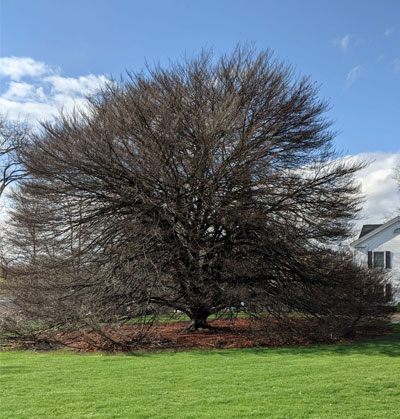║┌┴¤│ď╣¤═° Magazine Spring/Summer 2022
By Lisa Abraham, photos by Rami Daud, BA ÔÇÖ20
Imagine a day when OhioÔÇÖs environment is unable to sustain native trees like the sugar maple, which produces the sap distilled into Ohio maple syrupÔÇöor the Ohio buckeye, our state tree.
Research underway at the Climate Change Grove on the Kent Campus is shedding light on what may happen to native tree species if we donÔÇÖt address the carbon emissions that are causing global warming.
The tree grove, which sits on a parcel of land behind the Warren Recreation and Wellness Center, was established in 2018 through a partnership between University Facilities Management and the Department of Biological Sciences in the College of Arts and Sciences. The grove serves as a living laboratory for teaching biological sciences and conducting climate change research, as well as a reforestation effort.
Melissa Davis, BS ÔÇÖ04, MS ÔÇÖ10, horticultural facilities director for biological sciences, says she came up with the idea for the grove after attending a US Forest Service presentation on climate change.
ÔÇťThe idea was that, as the climate changes, the flora would either have to be able to adapt or would perish,ÔÇŁ says Davis, who immediately thought of trees. ÔÇťTrees are so special in our world. They clean the air we breathe, theyÔÇÖre a source of food (fruits and nuts) and shelter (building materials). They provide shade, help cool our homes and reduce our energy costs.ÔÇŁ
Davis thought the open space behind the recreation center would be the perfect spot for planting a variety of trees to see which could adapt as the climate warms.

Rebekkah Berryhill, BS ÔÇÖ02, grounds manager for facilities management,
and Melissa Davis, BS ÔÇÖ04, MS ÔÇÖ10, horticultural facilities director
for biological sciences, check out the reforestation efforts.
Rebekkah Berryhill, BS ÔÇÖ02, grounds manager for facilities management, says the grove represents a win for the university on several levels.
ÔÇťWeÔÇÖre always looking for partnerships to help students learn and to grow our canopy cover,ÔÇŁ she says, noting that previously the land was wasting resources. ÔÇťWe were using fuel to mow the area and treating it with herbicides and pesticides. ItÔÇÖs a beautiful stretch of land; the idea was maybe we could try to reforest it.ÔÇŁ
The grove was planted by students from biological sciences, many of whom are members of the Herrick Conservatory and Sustainability Club, which Davis advises, as well as faculty, staff, alumni and volunteers. Davis says little work was done during the pandemic, in 2020 and 2021, so a joint Arbor Day/Earth Day event took place on April 22, 2022, when members of the tree advisory board, the grounds department and volunteers from the Herrick student organization cleaned up the grove and assessed how the trees are faring.
The grove holds species native to Northeast Ohio, as well as others that typically require warmer climates to thrive.
ÔÇťClimates are changing so fast, species cannot adapt quickly enoughÔÇöand that is when we will lose species.ÔÇŁ
ÔÇöMelissa Davis
ÔÇťClimates have been changing throughout geological time frames,ÔÇŁ Davis says. ÔÇťThe problem now is climates are changing so fast, species cannot adapt quickly enoughÔÇöand that is when we will lose species.ÔÇŁ
Climate change models are as dynamic as climate change itself, Davis adds. ÔÇťThatÔÇÖs why I thought it would be interesting to test the models in a real-world application.ÔÇŁ
Research from the US Forest Service already suggests some startling examples of what trees will be winners and losers as OhioÔÇÖs climate changes. While earlier models for the sugar maple predicted substantial habitat decline in southern Ohio under harsh climate change, recent models rate the as highly adaptableÔÇöalthough under persistent drought or other stresses, it could still decline.
Among the losers would be two native species: black cherry and the Ohio buckeye. Davis says often people donÔÇÖt understand what is at stake.
ItÔÇÖs not too late, though, for the global community to take steps to reverse climate change and save native species from extinction, she says. ÔÇťA place like ║┌┴¤│ď╣¤═° that fosters education can do this outreach and become a part of this effort.ÔÇŁ
Special Campus Tree

This yearÔÇÖs Herrick Conservatory Plant Sale included cutleaf beech trees (Fagus sylvatica ÔÇśAsplenifoliaÔÇÖ). The trees were part of a grafting project that began just prior to the pandemic as a group effort with ║┌┴¤│ď╣¤═° Tree Advisory Board members, the Herrick student organization and partners from the Ohio Independent Arborist Association.
The effort was initiated to save a campus tree that dates to the time of the original carriage house, located next to the WomenÔÇÖs Center on Front Campus (see photo). The tree, which is reaching its maturity, was originally scheduled to be cut down to accommodate a new parking garage as part of a Master Planning phase, but that plan was abated when the pandemic hit.
ÔÇťItÔÇÖs a real winner in my book,ÔÇŁ says Melissa Davis, horticultural facilities director, noting that trees are listed as a tree species with ÔÇťnot much change predictedÔÇŁ in future changing climates.

Melissa Davis plants some new trees in the Climate Change Grove.

A glimpse at the grove site as volunteers assess the tree saplings.

A glimpse at the grove site as volunteers assess the tree saplings.
If members of the university community and beyond would like to own a piece of ║┌┴¤│ď╣¤═° history to plant in their own yards, this special horticultural variety is just $90/tree. Contact Melissa Davis at mdavis7@kent.edu or call 330-672-2469.
